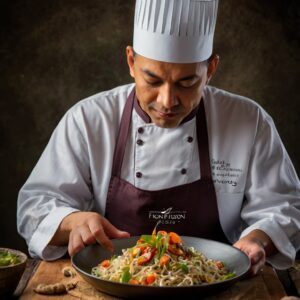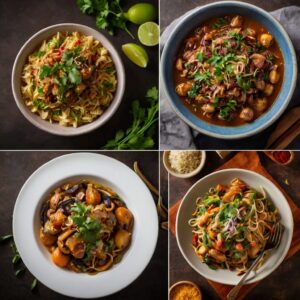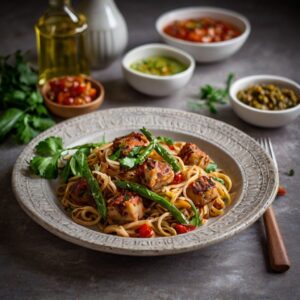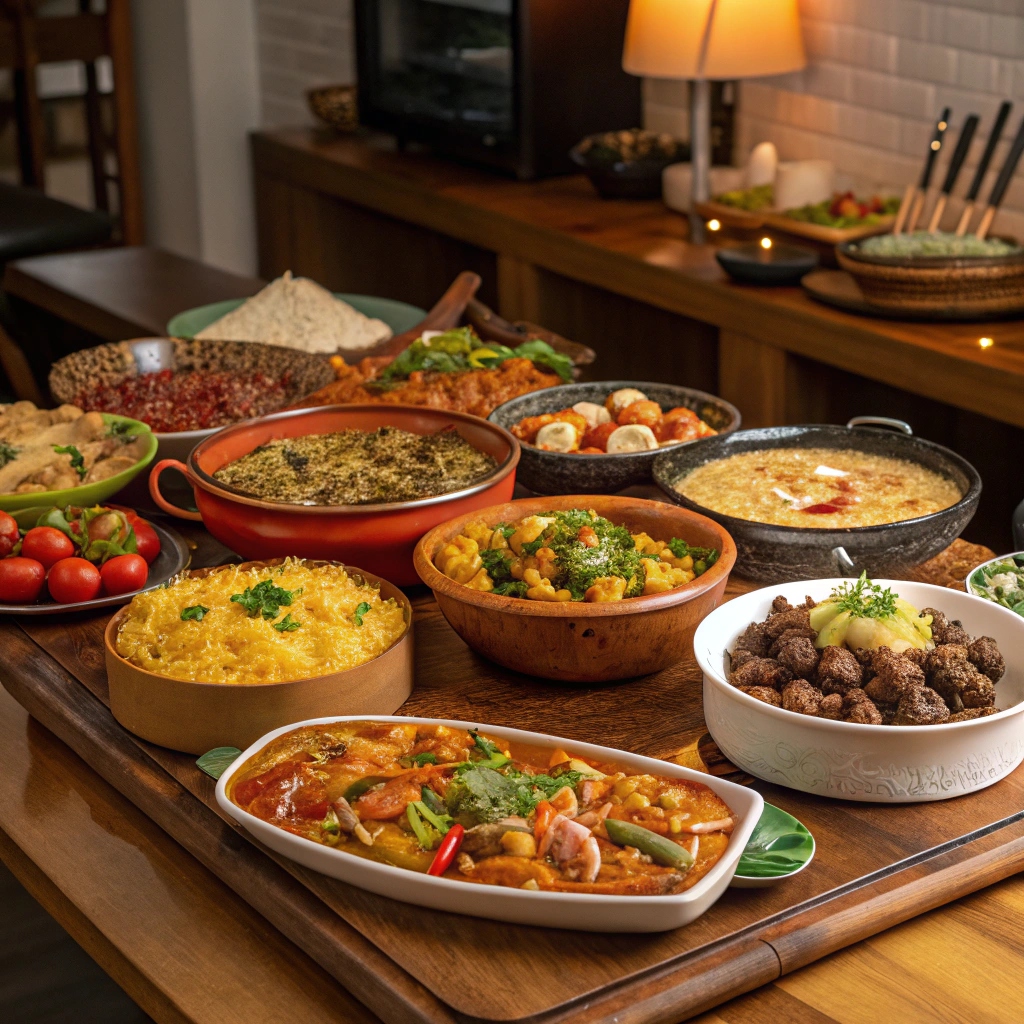Are you a foodie with wanderlust, tired of cooking up the same old dishes?
From Tokyo’s sushi chefs to Indian curry masters, there are countless flavors and spices waiting to be discovered.
But what if I told you that global fusion recipes can bring people together like nothing else?
By embracing these international flavors, home cooks can break free from monotony and create a more vibrant table.
Today’s leading chefs will share their expert tips for crafting authentic dishes that blend traditional techniques with modern flair.
Global Inspirations
Cultivating flavors of the world in your kitchen is a journey that requires curiosity, experimentation and patience. When it comes to creating global fusion recipes, inspiration can be drawn from anywhere – whether it’s the vibrant markets of India, the bold spices of Morocco or even the rich pasta dishes of Italy.
For many debut cookbook authors, their culinary journeys began with a desire to explore different cultures and ingredients. They scoured cookbooks and online forums for ideas on how to blend seemingly disparate flavors into cohesive meals that are both familiar and exotic.
A key secret is in understanding your global inspirations – what foods resonate within you? What spices or herbs evoke strong emotions or memories? This personal connection will guide the creation of recipes that truly stand out.
To create authentic dishes, it’s also essential to learn about various cuisines’ cooking techniques. In Italy for instance learning how pasta should be cooked can make a difference in your taste buds experience. Likewise understanding Korean chili flakes or Indian spices allows you to really bring out their flavor and depth.
Discovering Hidden Ingredients
 Hidden ingredients like fragrant spices, aromatic herbs, and edible flowers can take your cooking from ordinary to extraordinary. These unique flavor enhancers hold the key to creating truly fusion recipes that blend flavors from around the world.
Hidden ingredients like fragrant spices, aromatic herbs, and edible flowers can take your cooking from ordinary to extraordinary. These unique flavor enhancers hold the key to creating truly fusion recipes that blend flavors from around the world.
When did global cuisine become a melting pot of different cultures? The answer lies in these hidden ingredients. Instead of relying on generic seasonings, explore unexpected places for inspiration: fragrant spices, aromatic herbs, and edible flowers.
To add an authentic touch to your dishes without overpowering them with intense flavors or overwhelming aromas, focus on learning about specific ingredients like shiso leaves used in Japanese sushi recipes. This delicate herb adds a subtle twist that compliments seafood without masking its natural flavor.
Practical tips for incorporating these hidden ingredients into your cooking include:
- Infuse Asian-style curries by adding kaffir lime leaves to the pot during preparation.
- Use fresh thyme sprigs to add depth and warmth in Mediterranean-inspired stews.
- Garnish with edible flowers like violas or pansies to elevate simple salads.
When expert food bloggers talk about their favorite ingredients, they often reference cultural traditions that evoke emotions. For instance, Japanese chefs swear by the use of shiso leaves in sushi recipes. This fragrant herb adds an aromatic twist that compliments seafood without overpowering it.
To add an authentic touch to your cooking, focus on learning these unique flavor enhancers:
- Infused spices like Korean chili flakes can elevate Mexican dishes with a bold kick.
- Use dried lavender petals to create subtle, floral flavors in baked goods and desserts.
- Garam masala’s blend of Indian spices adds warmth to curries without overpowering their richness.
Want a secret ingredient that will take your Thai curry game from zero to hero? Try adding some lemongrass! Its citrusy freshness complements coconut milk perfectly.
Building Your Flavor Profile
To create truly unforgettable global fusion recipes, you need to understand how different flavors interact. At its core, a strong flavor profile is about understanding how different flavors balance each other out. It’s what sets apart a great dish from an okay one or makes it truly memorable.
There are several ways to build your own unique flavor profiles in global fusion recipes. Here are some expert tips:
Developing Aromatic Depth
Start with simple combinations like onion, garlic, and ginger for a solid foundation.
Try pairing these aromatics with other ingredients that complement their natural sweetness:
- Roasted sweet potatoes and caramelized onions create a deep, savory base.
- Garlic scapes add an allium-forward note when combined with fresh parsley or cilantro.
- Ginger pairs surprisingly well with dried cranberries in some Asian-inspired recipes.
For others, developing aromatics is just the beginning.
Experimenting with different types of citrus or spices can add depth and complexity to your flavor profiles:
- Orange zest adds a bright, citrusy zing when used in combination with dark chocolate or nuts.
- Smoked paprika enhances smoky flavors when paired with roasted sweet potatoes.
- Ginger, garlic, and chili flakes create an aromatic blend often used in Southeast Asian cuisine.
Balancing Sweet, Sour, and Savory
Balancing flavor profiles is key. Consider how ingredients will react when combined:
- Sweetness can be balanced by acidity or bitterness (think citrus-herb combinations) to prevent overpowering the dish.
- Sour flavors add brightness when paired with rich, savory elements like umami-rich meats or starchy grains.
- A balance of textures and temperatures hot and cold, crunchy and soft enhances the sensory experience.
Incorporating umami flavor enhancers can also help achieve a better equilibrium:
- Soy sauce brings salty depth to noodle dishes.
- Miso paste adds rich, savory goodness when used in soups or sauces.
Embracing Texture
Think about texture: crunch from nuts or seeds, creaminess from avocado or yogurt, and softness from cooked grains or legumes.
This can be achieved by experimenting with various ingredients:
- A crunchy peanut sauce pairs nicely with sweet potatoes and vegetables.
- Avocado adds creaminess to both Mexican dishes (like guacamole) and Italian recipes.
As one expert food blogger puts it: “Flavor profile building is not a one-time event; it’s an ongoing process that requires constant experimentation, observation, and iteration.”
Creating Harmonious Combinations
 The secret to crafting delicious global fusion dishes lies in understanding how different ingredients interact with each other. To unlock its full potential, it’s essential to grasp how various flavor components work together.
The secret to crafting delicious global fusion dishes lies in understanding how different ingredients interact with each other. To unlock its full potential, it’s essential to grasp how various flavor components work together.
When cooking up a storm of flavors, balance is key. Just as music requires harmony between melody and rhythm, so does cooking. You need to strike the right chord by balancing sweet, sour, salty, and spicy flavors in each dish.
In Korean cuisine for instance ,balance heat from chili flakes (gochugaru) with sweetness.
A pinch of sugar balances out the spiciness perfectly in some traditional korean recipes
The same principle applies to other cuisines. In Japanese cooking,
a drizzle of soy sauce counteracts richness
dashi broth, while
cumin seeds complement spiciness.
Understanding flavor profiles is also crucial for creating harmonious combinations.
This involves analyzing each ingredient’s unique characteristics and finding the perfect pairing.
Here are some more examples to inspire your culinary adventures:
- When you combine Asian-inspired soy sauce and honey, you get a sweet-savory harmony that’s nothing short of magic.
- Bright citrusy lemon zest mixed with warm spicy ginger creates refreshing Mexican salsa.
- Korean chili flakes (gochugaru) added in small amounts create heat
- cumin seeds with rich coconut milk make for an exotic Indian dessert.
Remember practice makes perfect. Try new ingredients and flavors, even if they seem unusual or unexpected – it’s often those surprise pairings that lead to the most delicious results!
Adapting to New Cooking Techniques
To create global fusion recipes, you must first adapt new cooking techniques.
When experimenting with unfamiliar methods, many cooks feel hesitant and unsure of where to begin. To overcome this obstacle, learn about different cultures’ approaches by reading cookbooks from other countries. Look at their ingredient lists, flavor combinations, and how they prepare dishes that are the opposite of what you’re used to.
For instance, trying Japanese ‘umami’ seasonings can add depth and complexity to your recipes. Start by adding small amounts (e.g., 1/4 teaspoon) before scaling up. What if you discovered an entire world of flavors just waiting to be discovered in unexpected places? From Indian spices to Mediterranean herbs, the possibilities are endless!
Chef Ramses suggests trying new ingredients or cooking techniques in small increments before incorporating them into your entire recipe so it doesn’t throw off a delicate balance.
When analyzing historical culinary traditions, look at how various social factors and economic conditions influenced traditional recipes. Understanding these roots can help you appreciate the evolution of cuisine over time.
In Japan, for example, umami flavors have been used to enhance dishes since the 15th century. This cultural emphasis on savory flavor profiles is what makes Japanese cuisine so unique. By studying historical traditions like this, we gain insight into how food has shaped cultures and societies throughout history.
To incorporate new ingredients or cooking techniques into your recipes without disrupting their balance, follow these practical tips:
- Start by experimenting with small amounts to test the flavors.
- Learn from cookbooks and experts who have successfully fused global cuisines in unique ways.
- Pay attention to cultural influences that shape traditional recipes, such as historical trade routes or economic conditions.
By following these steps and being open-minded, you can unlock a world of flavors just waiting to be discovered.
Balancing Sweet and Savory Flavors
When it comes to cooking globally-inspired dishes, there’s a sweet and savory secret waiting to be unlocked. The key lies not in combining ingredients, but in finding harmony among them.
Imagine biting into a juicy Korean-style BBQ taco with crispy kimchi slaw the combination of spicy kick from chili flakes and tangy lime juice creates an irresistible tension that will leave you craving for more.
Sweet flavors can draw heat from spices like cinnamon or nutmeg, while cool elements like yogurt or sour cream offer respite. This delicate balance is what sets truly unforgettable dishes apart. For instance, pair sweet ripe mangoes with the savory umami of cilantro to elevate Southeast Asian-inspired dishes.
To strike a chord between hot and cool flavors requires an understanding of their inherent chemistry: sweetness draws heat while savory depth often involves cold temperatures. Sweet ingredients like honey or sugar can draw out rich flavors from other ingredients, creating harmony in unexpected places.
Incorporating contrasting elements, such as spicy salsa with cooling sour cream or smoky BBQ sauce with crunchy cilantro, adds a layer of complexity to your dishes that will leave diners eagerly anticipating the next bite. The best approach is not about striking an exact balance but rather finding the sweet spot where opposing flavors dance in perfect harmony.
Ultimately, mastering this art can make all the difference between a bland meal and one that’s truly memorable, so experiment with new combinations and discover your own unique flavor profiles.
Exploring Exotic Spices and Herbs
 The key to making an amazing dish is not just about picking one or two ingredients from different cultures but also combining them in innovative ways. By choosing exotic spices and herbs that aren’t typically used together, you can give your dishes a new identity.
The key to making an amazing dish is not just about picking one or two ingredients from different cultures but also combining them in innovative ways. By choosing exotic spices and herbs that aren’t typically used together, you can give your dishes a new identity.
In Indian cuisine, saffron is often paired with cardamom and cinnamon to create a warm, aromatic blend that complements the rich flavors of basmati rice or naan bread. This subtle earthy sweetness pairs well with citrusy notes in dishes like biryanis. With its luxurious price tag and vibrant yellow color, it’s no wonder why chefs love using saffron to elevate their creations.
Curry leaves are a staple in Indian cuisine, adding a lot of depth and warmth to your dish. In curries and chutneys, they’re commonly used as a flavor enhancer. Their distinctive aroma is often combined with spices like turmeric and cumin to create complex flavor profiles. In Southeast Asian cuisine, curry leaves pair well with lemongrass and galangal, adding an authentic touch to soups and braises.
Mint is the go-to herb in Middle Eastern and Central Asian cuisine. It’s refreshing on its own or adds a zing when paired with other herbs like basil. The smell of fresh mint pairs surprisingly well with cinnamon! You can use it as a garnish, add it to salads, or even create refreshing drinks.
In Mexican and Indian cuisine, cilantro has been used for centuries to add freshness and depth. This pungent green is perfect for salsas or salads. Its citrusy flavor complements other herbs like lime juice beautifully. Whether you’re adding a burst of flavor or a pop of color, cilantro never fails.
Ginger is the unsung hero in Asian and Indian cuisine, adding warmth and spice to any dish. When combined with chilies or garlic, it creates some truly unique flavors that can elevate your cooking to new heights.
Are there other herbs and spices out there waiting to be discovered? The world of global fusion recipes is full of endless possibilities!
Developing Your Own Signature Recipes
Creating truly memorable global fusion recipes requires embracing bold flavors and techniques. To start your culinary journey, try pairing two ingredients that complement each other but may seem unusual at first glance like Korean chili flakes with sweet potatoes. This unexpected combination sparks a spicy-sweet flavor profile that can be incorporated into various dishes, such as soups or stews.
For instance, combining the classic Japanese concept of sushi rolls with Mexican tacos takes the ordinary to new heights. Using rice instead of traditional taco shells creates an exciting twist on a beloved dish, allowing you to experiment with diverse flavors and ingredients in innovative ways. This approach is popular among expert food bloggers like Yotam Ottolenghi and Samin Nosrat, who have used Korean chili flakes as a key component in their Indian-inspired curries.
Embracing bold flavors and spices can also help define your signature style. Take the Italian dish chicken parmesan for example; adding Indian-inspired spices to create a unique twist is not only delicious but also showcases the versatility of global cuisine. Food blogger Giada De Laurentiis has experimented with this approach, incorporating cumin and coriander into her pasta sauces for an exotic flavor profile.
Don’t be afraid to make mistakes in the kitchen; they’re inevitable but valuable learning opportunities for improvement. When experimenting with new flavors, remember that trial and error is a crucial part of refining your culinary skills. By embracing this process, you’ll develop unique recipes that blend diverse tastes into something entirely new. Take food blogger Deb Perelman’s approach to Korean chili flakes-infused BBQ sauce as an example; it may not have been an immediate success, but with persistence and practice, her signature style has evolved.
Through trial and error in the kitchen, you can create dishes that are truly one-of-a-kind. Embracing global flavors and experimenting with different techniques allows for creativity and innovation in your cooking. By embracing this process, you’ll develop unique recipes that showcase your personal touch.
Culinary Innovation for Your Next Meal Time Adventure
Great cooks won’t be waiting around all day. The world is a global village, and your taste buds will thank you when flavors from everywhere are at the table.
And So, the sooner you experiment with new ingredients and techniques, the more likely it is that your dishes will become truly unforgettable.
So trust those food bloggers to inspire a love of international cuisine in their readers. From traditional recipes to modern twists on classics, cooking should never be boring when there’s such beauty found around every corner.
Take bold action today by stepping out of your comfort zone and embracing the flavors that make life worth savoring – Your taste buds will thank you for it.




